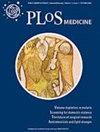维州结核病流行率变化的社会决定因素ệ越南:人口水平的横断面研究分析
IF 9.9
1区 医学
Q1 MEDICINE, GENERAL & INTERNAL
引用次数: 3
摘要
背景已经观察到经济发展与结核病流行率降低之间的生态关系。2007年至2017年间,Việ越南经济发展迅速,资源分配公平,结核病发病率下降37%。通过分析连续的流行率调查,我们研究了结核病(和亚临床结核病)流行率的降低是如何集中在社会经济群体之间的。方法和发现我们结合了2个具有全国代表性的Việt采用省级贫困衡量标准进行的越南结核病流行率调查。包括94156(2007)和61763(2017)个人的数据。在经微生物证实的结核病患者中,2007年21.6%(47/218)和2017年29.0%(36/124)患有亚临床疾病。我们使用消费数据的主成分分析构建了一个资产指数。疾病集中度指数用于衡量结核病流行率中的社会经济地位不平等。疾病集中度指数从2007年的−0.10(95%CI−0.08,−0.16;p=0.003)变化到2017年的0.07(95%CI 0.06,0.18;p=0.158),表明结核病在2007年集中在最贫穷的家庭中,2017年富裕家庭和贫困家庭之间的分配更加平等。这一发现与亚临床结核病相似。我们拟合了多层次模型来调查结核病流行率、个人风险、家庭社会经济地位和社区贫困之间的关系。控制省级贫困水平降低了患病率的差异,表明邻里贫困的变化有助于解释结核病患病率的变化。我们研究的一个局限性是,尽管结核病流行率调查有助于了解各国结核病流行率的社会经济差异,但鉴于结核病在研究人群中是一种相对罕见的疾病,探索社会经济驱动因素的能力有限。然而,在经济显著增长的时期,将重复的横断面调查与省级贫困估计相结合,可以对结核病与Vi经济发展之间的动态关系提供有价值的见解ệt Nam。结论我们发现,随着经济的公平增长和结核病负担的减轻,结核病在Vi的穷人中的集中程度降低ệt Nam。本文章由计算机程序翻译,如有差异,请以英文原文为准。
Social determinants of the changing tuberculosis prevalence in Việt Nam: Analysis of population-level cross-sectional studies
Background An ecological relationship between economic development and reduction in tuberculosis prevalence has been observed. Between 2007 and 2017, Việt Nam experienced rapid economic development with equitable distribution of resources and a 37% reduction in tuberculosis prevalence. Analysing consecutive prevalence surveys, we examined how the reduction in tuberculosis (and subclinical tuberculosis) prevalence was concentrated between socioeconomic groups. Methods and findings We combined data from 2 nationally representative Việt Nam tuberculosis prevalence surveys with provincial-level measures of poverty. Data from 94,156 (2007) and 61,763 (2017) individuals were included. Of people with microbiologically confirmed tuberculosis, 21.6% (47/218) in 2007 and 29.0% (36/124) in 2017 had subclinical disease. We constructed an asset index using principal component analysis of consumption data. An illness concentration index was estimated to measure socioeconomic position inequality in tuberculosis prevalence. The illness concentration index changed from −0.10 (95% CI −0.08, −0.16; p = 0.003) in 2007 to 0.07 (95% CI 0.06, 0.18; p = 0.158) in 2017, indicating that tuberculosis was concentrated among the poorest households in 2007, with a shift towards more equal distribution between rich and poor households in 2017. This finding was similar for subclinical tuberculosis. We fitted multilevel models to investigate relationships between change in tuberculosis prevalence, individual risks, household socioeconomic position, and neighbourhood poverty. Controlling for provincial poverty level reduced the difference in prevalence, suggesting that changes in neighbourhood poverty contribute to the explanation of change in tuberculosis prevalence. A limitation of our study is that while tuberculosis prevalence surveys are valuable for understanding socioeconomic differences in tuberculosis prevalence in countries, given that tuberculosis is a relatively rare disease in the population studied, there is limited power to explore socioeconomic drivers. However, combining repeated cross-sectional surveys with provincial deprivation estimates during a period of remarkable economic growth provides valuable insights into the dynamics of the relationship between tuberculosis and economic development in Việt Nam. Conclusions We found that with equitable economic growth and a reduction in tuberculosis burden, tuberculosis became less concentrated among the poor in Việt Nam.
求助全文
通过发布文献求助,成功后即可免费获取论文全文。
去求助
来源期刊

PLoS Medicine
医学-医学:内科
CiteScore
21.60
自引率
0.60%
发文量
227
审稿时长
3 months
期刊介绍:
PLOS Medicine aims to be a leading platform for research and analysis on the global health challenges faced by humanity. The journal covers a wide range of topics, including biomedicine, the environment, society, and politics, that affect the well-being of individuals worldwide. It particularly highlights studies that contribute to clinical practice, health policy, or our understanding of disease mechanisms, with the ultimate goal of improving health outcomes in diverse settings.
Unwavering in its commitment to ethical standards, PLOS Medicine ensures integrity in medical publishing. This includes actively managing and transparently disclosing any conflicts of interest during the reporting, peer review, and publication processes. The journal promotes transparency by providing visibility into the review and publication procedures. It also encourages data sharing and the reuse of published work. Author rights are upheld, allowing them to retain copyright. Furthermore, PLOS Medicine strongly supports Open Access publishing, making research articles freely available to all without restrictions, facilitating widespread dissemination of knowledge. The journal does not endorse drug or medical device advertising and refrains from exclusive sales of reprints to avoid conflicts of interest.
 求助内容:
求助内容: 应助结果提醒方式:
应助结果提醒方式:


